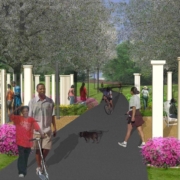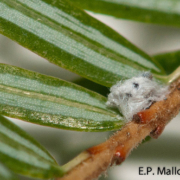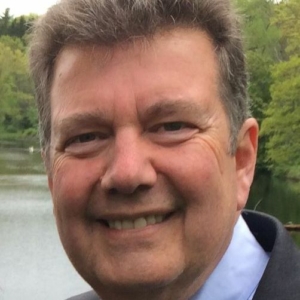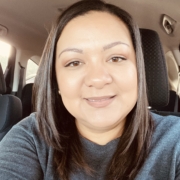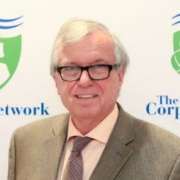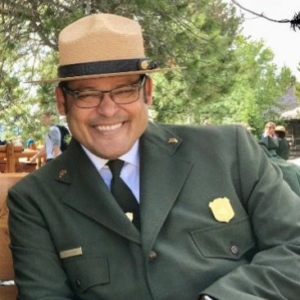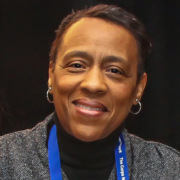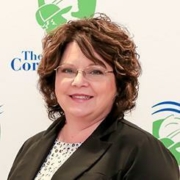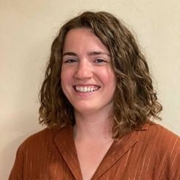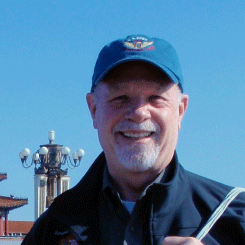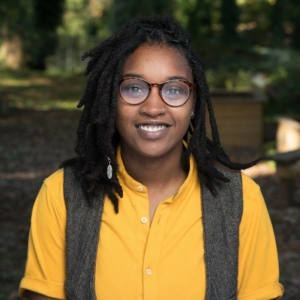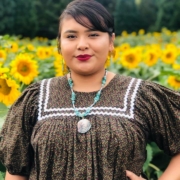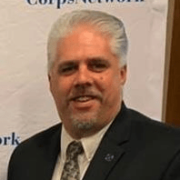Recently The Corps Network began working with The Peace Corps to foster greater connections between our organizations. At its heart, the goal of our partnership is to connect domestic community service possibilities to international service possibilities– and vice-versa. We believe that the power and value of service stretches beyond borders.
To showcase this connection, we are highlighting stories of individuals who are serving or have served for one of our 158 Service and Conservation Corps and as volunteers in the Peace Corps.
Current Staff Members
Mark Howard

Peace Corps Service: Restoration Specialist, 2001-2003 in Palawan, Philippines
Currently with EarthCorps (Seattle, Washington) as Sr. International Program Manager, 2003-present
After earning a Wildlife Biology degree, Mark served in Peace Corps. When it came time to for EarthCorps to hire a manager for our international program, Mark stood out among more than 250 applicants. Mark secured EarthCorps’ J-1 exchange designation, enabling EarthCorps to effectively work as a ‘reverse Peace Corps’ by bringing young leaders from around the world to Seattle to serve alongside AmeriCorps members. EarthCorps international alumni now span 76 countries and are working to create change in numerous ways. Several alumni have launched conservation corps programs in their home communities. Mark holds a Master’s in Executive Nonprofit Leadership from Seattle University. Mark served on the boards of InterConnection and the Association of Washington International Student Advisors. He is a graduate of Leadership Tomorrow. Mark currently serves on the board of EarthShare Washington. Mark recently traveled to Washington, DC to celebrate his 10th anniversary reunion with his Peace Corps cohort.
Earl Millett, Jr.

Peace Corps Service: 2003-2005 in Ecuador
Currently with Civic Works (Baltimore, Maryland) as Community Development Director, 2006-present
Earl Millett began his career in service in 2000 when he joined AmeriCorps as a full-time member serving with Volunteer Maryland. He worked to establish a formal volunteer program at Garden Harvest, a Maryland organic farm that donates its produce to soup kitchens and homeless shelters. He began a second full-time term with Volunteer Maryland in 2001, mentoring 12 new AmeriCorps members and helping them establish volunteer programs at small nonprofit organizations.
Earl joined the Peace Corps in 2003, spending two years in Ecuador working with the Charles Darwin Foundation on the Galapagos Island of San Cristobal. Most of his efforts focused on environmental curriculum development for the local schools (which resulted in the island’s first annual science fair) and teaching organic farming techniques to the local farmers to encourage sustainability on the island.
When Earl returned to the United States in 2005, the gulf coast was struck by Hurricanes Rita and Katrina. Earl joined the Crisis Corps (now called Peace Corps Response) and was eventually assigned to St. Bernard’s parrish in New Orleans. He trained a local resident, who had lost his supermarket in the storms, to take over his recovery efforts. He was able to get funding for the gentleman to be paid for a year through FEMA.
Early in 2006, Earl joined Civic Works as a Volunteer Coordinator, helping others benefit from the opportunities he enjoyed serving in AmeriCorps. Since then, he has worked to develop new programs and acquire new funding, expanding Civic Works’ capacity in volunteers and clients served. He currently directs several programs, handling management of supervisors and administration of budgets. He stays involved on a day to day basis talking to prospective AmeriCorps members to determine their best fit, and as a resource for all Civic Works members during and after service.
In 2011, Earl received tremendous recognition by being honored by the White House as a Champion of Change.
Jammie Kingham

Peace Corps Service: Restoration Specialist, 2002-2004 in Palawan, Philippines
Currently with EarthCorps (Seattle, Washington) as Corpsmember/Crew leader, 2000-2001 and Senior Project manager, 2006-present
Jammie came to EarthCorps as a young adult fresh out of college with a degree in urban forestry. Armed with her education and unique set of talents (state champion double bit axe thrower and elite gymnast are just a couple), Jammie set out to make a tangible difference in the environment and landed at EarthCorps as an AmeriCorps member pulling invasive and planting trees. Her work ethic, determination and leadership were evident from the start and she was promoted to crew leader for her second year of service. Her EarthCorps service influenced her to seek a greater global restoration perspective and she enthusiastically accepted a position as a restoration specialist with the Palawan Conservation Corps. During her Peace Corps tenure, her resolution to continue in the field of community based restoration grew in magnitude and when a full time position opened up at EarthCorps – it was a glove like fit for both of us. Since, her first position as Education Coordinator, Jammie’s extraordinary influence on over three hundred corps members is irrefutable. She is a role model for each and every one of them to do their best, to dream big and to value their service.
Sharon London

Peace Corps Service: Thailand
Currently with EarthCorps (Seattle Washington) as Education Director
Sharon has experience as both a natural resource manager and educator. She served as Executive Director with Seattle Urban Nature which joined forces with EarthCorps, and with Homewaters Project, an organization that connects Seattle area school children with local nature and community using inquiry based science and GIS. She performed GIS analysis on salmon habitat at the National Marine Fisheries Science Center, NOAA. Sharon served as an advisor for Lao forestry officials assisting in the establishment of a trans-boundary protected area between Laos and Vietnam with World Wide Fund. She taught as an adjunct faculty in Geography at Western Washington University and Antioch University. Sharon was a US Peace Corps Volunteer in Thailand focused on environmental education. She holds an M.S. in Geography from Oregon State University with a focus on GIS and Forestry and a B.A. in Geography from the University of California at Berkeley.
Kate Stephens

Peace Corps Service: 1999-2001 in Ecuador
Currently with Utah Conservation Corps as Assistant Director
Kate started her national service career as a VISTA in 1993 with Options for Independence,a Logan, UT non-profit dedicated to giving people with disabilities skills to gain more control and independence over their lives. Kate used that experience to found Common Ground Outdoor Adventures, a non-profit that provides life-enhancing outdoor recreational opportunities for youth and adults with disabilities. Kate went on to serve with the Peace Corps in Ecuador from 1999-2001. Upon returning to Utah, Kate joined the recently-founded Utah Conservation Corps, an AmeriCorps-funded conservation corps based at Utah State University.
In Kate’s tenure at the UCC she has used her experiences in Peace Corps and national service to make the organization a leader in including diverse populations in service. In 2007, Kate worked to start the Inclusive Crew Project in partnership with The Corps Network, Mitsubishi Electric America Foundation, and multiple public land management agencies. The Inclusive Crew Project has brought AmeriCorps service opportunities to persons with disabilities within the realm of a traditional conservation corps. Kate has worked with several partners to publish the Inclusion Toolkit that documents best practices and information for other organizations considering broadening service opportunities to persons with disabilities.
Kate has also been instrumental in transforming UCC’s past youth conservation corps program into the Bilingual Youth Corps in 2010. Under Kate’s leadership the Bilingual Youth Corps expanded service opportunities to underserved Spanish-speaking high school students in Cache County. All recruitment, training, and environmental education materials for this crew are available in both English and Spanish. Finally, Kate was instrumental this past year in the creation of UCC’s veterans crew. The veterans crew was comprised of four young adult veterans that completed a variety of natural resource conservation projects throughout the state.
Angela Welfley

Peace Corps Service: 1998-2000 in El Salvador
Currently with Montana Conservation Corps as Regional Program Coordinator
An Idaho native, Angela Welfley earned a Bachelor of Science degree in Biology from Boise State University in 1997 before leaving the following year to join the Peace Corps in El Salvador. From 1998 to 2000, she served as an AgroForestry volunteer in the Salvadoran community of Chalatenango where she partnered with La Asociación Ecológica de Chalatenango and the local high school to engage over 300 students earning social hours in a variety of environmental education activities. Together they were able to establish and maintain a native plant nursery that resulted in thousands of donated trees to local organizations and surrounding communities. She solicited a donation of environmental education resources and engaged a small group of students in a series of environmental presentations given at the local elementary schools. Angela also collaborated with other Peace Corps volunteers to organize and host the first Peace Corps El Salvador Environmental Youth Camp as well as a multi-day educational/professional workshop for young women from rural communities.
After her return to the United States, Angela served two consecutive AmeriCorps terms with the Montana Conservation Corps, first as Crew Leader and then Senior Crew Leader. For those two terms, she provided leadership to crews and direct conservation service to Montana’s public lands and communities on projects that include: miles of trail construction and maintenance, habitat restoration in Glacier National Park, collaborative support to the Kalispell Human Resource Development Council’s self-help housing project, and more.
In 2004, after finishing with AmeriCorps, Angela went on to work with the Southeast Alaska Guidance Association’s Serve Alaska Youth Corps program where she mentored native Alaskan youth and continued her conservation efforts. Later that year, she returned to the Montana Conservation Corps in Bozeman, which is where she currently continues to work as a Regional Program Coordinator. Through her professional work, Angela has dedicated herself to empowering the young people of America and to protecting the lands that she both utilizes and loves. This year alone, she will directly impact the lives of over 56 young adults and nearly 30 Montana youth through training and mentoring. Over the years, she has worked with several hundred AmeriCorps members and local youth, and has contributed to community and conservation projects throughout Yellowstone and Grand Teton National Parks, the Big Hole National Battlefield, and nearly a dozen national forests within three different states. For several years, she has also helped to coordinate the Corps’ efforts in weatherizing more than 2000 Montana residences during the Warm Hearts Warm Homes statewide energy assistance project.
Within her own community of Bozeman, Angela has served on an advisory council that launched a volunteer coordinating website and has been a long time volunteer with a local adaptive ski program that provides recreational opportunities for people with disabilities.
Current Corpsmembers
Max Gordon

Peace Corps Service: Madagascar
Currently a Corpsmember with Earthcorps (Seattle, Washington)
“I was serving the second of two positions with SCA through their Native Plant Corps at Grand Canyon this past fall. I want to serve with an organization that is doing the sort of work I wish to pursue as a career in the very place where I want to live.”
Melissa Harrington

Peace Corps Service: Ghana
Currently a Corpsmember with Earthcorps (Seattle, Washington)
“In November 2009, I returned home from Ghana, where I spent 2 years in the Peace Corps. After readjusting to the US somewhat (or small-small), I packed my bags, jumped on a plane to the other coast, and here I am. My dream job is to promote environmental awareness and sustainable agriculture in the third world.”
Alumni
Chris Honeycutt
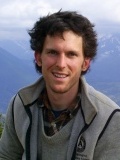
Domestic Service: Earthcorps Corpsmember
Currently a Peace Corps Volunteer in The Gambia.
Chris is on his third year as a U.S. Peace Corps Volunteer in The Gambia. He has been tasked with working alongside local community members to develop environmental projects. Hi most recent goal is to protect James Island, a UNESCO World Heritage Site from further erosion.
“I totally get to use my education and training from Earth Corps. We have had two volunteer events and the villagers have loved the work. Many of them have lived their entire lives in the area and have never set foot on the island – only hearing stories of the place from oral traditions. And the word is spreading, as we provide work for locals (in quarrying rock) and through interest in volunteering. We are getting a great site history and volunteers from local schools, Peace Corps, communities, are all coming to lend a hand.”
Katherine Le Lacheur

Peace Corps Service: 1993-1995 in Honduras
Domestic Service: Americorps National Civilian Community Corps (Charleston, South Carolina)
Katherine Gregory Le Lacheur is the Senior Director for the Girl Scouts of Eastern Massachusetts (GSEM). In 2009, GS of Eastern Massachusetts consolidated the operations of three councils into a single council that serves more than 42,000 girls and 17,000 adults in 178 communities. This makes GSEM the largest all-girl leadership program in New England and one of the largest Girl Scout councils in the United States. Katherine has been with the Girl Scouts for nearly 10 years, also serving as the Director of Program and Training from 2000-2004, and Regional Director for membership from 2004 – 2010.
Prior to joining the Girls Scouts in 2000, Katherine served as a Senior Team Leader for Class IV at AmeriCorps National Civilian Community Corps ‘s Southeast Campus in Charleston, South Carolina. She supported nine team leaders and over 100 Corps Members through their year of service. As a Class III NCCC Team Leader, also at the Charleston campus, Katherine led and served with a team of 11 Corps Members on projects such as building homes in Florida, invasive species removal in South Carolina and refurbishing public housing in Washington DC.
Before her AmeriCorps NCCC experience, Katherine was a Peace Corps Volunteer in Honduras (1993-1995) where she served as an environmental educator. Leading up to her Peace Corps service, Katherine was a New York City Public School teacher.
Katherine holds a Masters Degree in Non-Profit Management from Brandeis University’s Heller School and obtained her Bachelor’s Degree in Education from City University of New York at Queens. Despite being a life-long Yankees fan, Katherine currently lives in Massachusetts with her husband Leroy, and their son Oliver.
Juan Perez

Domestic Service: Earthcorps Corpsmember
Currently a Programming and Training Specialist with Peace Corps in Panama
Juan spent 12 months at EarthCorps before returning to Panama to take a job with the U.S. Peace Corps. He is now the Programming and Training Specialist for Environmental Health programs. Juan says his international leadership experience from EarthCorps now helps him mentor U.S. Peace Corps Volunteers serving in Panama.





